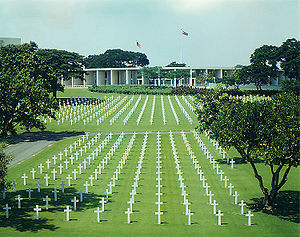| Manila American Cemetery and Memorial | |
|---|---|
| American Battle Monuments Commission | |
 Manila American Cemetery headstones with memorial building behind. | |
| Used for those deceased 1941–1945 | |
| Established | 1948 |
| Location | 14°32′28″N 121°03′00″E / 14.541°N 121.050°E |
| Designed by | Gardener A. Dailey |
| Total burials | 17,206 |
Unknowns | 3,744 |
| Burials by nation | |
* United States: 16,636
| |
| Burials by war | |
* World War II: 17,206 | |
| Statistics source: American Battle Monuments Commission | |



The Manila American Cemetery and Memorial is a military cemetery located in Fort Bonifacio, Taguig. It can be reached most easily from the city via EDSA to McKinley Road, then to McKinley Parkway inside the Bonifacio Global City. The Lawton Avenue, formerly the Nichols Field Road, is the easiest access from Ninoy Aquino International Airport to the cemetery.[1] It falls under the jurisdiction of Barangay Fort Bonifacio,[2] having been previously part of Barangay Ususan prior to Fort Bonifacio's creation in 2008.[3] Makati also claimed jurisdiction of the cemetery as part of Barangay Post Proper Southside, which was later transferred to Taguig as part of the 2021 Supreme Court decision on the boundary dispute.
The cemetery, 152 acres or 620,000 square meters in area, is located on a prominent plateau, visible at a distance from the east, south and west.[1] With a total of 17,206 graves, it has the largest number of graves of any cemetery for U.S. personnel killed during World War II and holds war dead from the Philippines and other allied nations.[1] Many of the personnel whose remains are interred or represented were killed in New Guinea, or during the 1941–42 Battle of the Philippines or the Allied recapture of the islands.[1] The headstones are made of marble which are aligned in eleven plots forming a generally circular pattern, set among a wide variety of tropical trees and shrubbery.[1] The Memorial is maintained by the American Battle Monuments Commission.
The cemetery is open daily to the public from 9:00 a.m. to 5:00 p.m. PHT except December 25 and January 1.[1]
The cemetery also contains one Commonwealth War Dead burial from World War I.[4]
- ^ a b c d e f "Manila American Cemetery and Memorial". The American Battle Monuments Commission. Retrieved February 18, 2013.
- ^ Lim, Michael (2018). "Mayor Lani joins US Memorial Day Ceremony". Metro News Central. Retrieved February 16, 2024.
- ^ G.R. No. 168781 (September 14, 2007), City of Makati vs. The Hon. Judge Briccio C. Ygaã‘a, and Municipality of Taguig, retrieved November 19, 2023
- ^ "American Military Cemetery, Fort Bonifacio, Manila | Cemetery Details | CWGC".